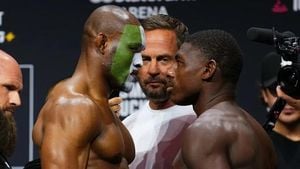Saturday Night Live (SNL) has been a cornerstone of American comedy since its debut in 1975, captivating audiences with its unique blend of satire, sketch comedy, and celebrity hosts. As the show celebrates its 50th anniversary, Peacock’s four-part docuseries SNL50: Beyond Saturday Night offers an intimate look behind the curtain, revealing the creative chaos and cultural impact that have defined the program for decades.
Executive producer Morgan Neville and director Marshall Curry have crafted a series that dives deep into the essence of SNL through four distinct episodes: "Five Minutes," focusing on the audition process; "More Cowbell," exploring the genesis and legacy of one of the show’s most iconic sketches; "Written By: A Week Inside the SNL Writers Room," a raw look at the intense sketch-writing process; and "Season 11: The Weird Year," a candid retrospective of what many consider the show’s most tumultuous season.
Neville, a self-professed comedy aficionado, explained to Gold Derby how he narrowed down his initial dozen ideas to these four compelling narratives. "I proposed telling specific stories that feel like meals unto themselves rather than a chronological history or clip show," he said. This approach offers viewers a fresh perspective on the show’s inner workings, from the nerve-wracking auditions that launch careers to the creative struggles that define its worst season.
The episode directed by Marshall Curry, "Written By," stands out for its unprecedented access to the SNL writers’ room during a full week of production. Curry described the experience as both exhilarating and exhausting. "One writer told us, 'This is the greatest job I could ever imagine having. And also my mental health is the worst that it’s ever been in my life.'" This paradox captures the high-pressure environment where humor is crafted under relentless deadlines and intense scrutiny.
The docuseries reveals the Monday night pitch meeting as more of a ritualistic charade than a serious brainstorming session. Neville explained, "The whole point of the Monday night meeting is just to get the host to feel like you're not alone in this. There are a lot of people here who are trying to be funny, but not necessarily trying to pitch you the sketch." This insight sheds light on the delicate balance between collaboration and competition that fuels the show's creative engine.
Season 11, often cited as SNL’s nadir, is given a nuanced treatment in the docuseries. Convincing cast members like Damon Wayans and Anthony Michael Hall to participate was challenging, as they were initially hesitant about revisiting a painful chapter. Yet, Neville sees this failure as pivotal: "Without that failure, SNL wouldn’t have survived. That cast included some incredible comedians; it just wasn’t the right recipe that year." This reflection underscores how setbacks can lead to reinvention and resilience.
Beyond the docuseries, the legacy of SNL is also celebrated through the unforgettable performances of its hosts. Few have embodied the spirit of the show like Tom Hanks, whose multiple appearances have left an indelible mark. Hanks made his SNL debut in 1985, during the very Season 11 the docuseries spotlights. At just 29, he brought a fresh energy to the show, playing an Entertainment Tonight host in his first sketch and even sitting in on writing sessions—a rarity for hosts at the time.
Hanks’ versatility shone through memorable characters such as Mr. Short-Term Memory, an ad executive who forgets everything seconds after hearing it, a sketch created by Conan O’Brien that ran from 1988 to 1990. His ability to blend seamlessly into the SNL universe was further demonstrated in the 1990 "Wayne’s World Roadie" sketch, where he played Barry, a roadie for Aerosmith, alongside Mike Myers and Dana Carvey.
Perhaps Hanks’ most viral moment came in 2016 with his portrayal of David S. Pumpkins in the Halloween-themed "Haunted Elevator" sketch. Dressed in a bizarre orange suit and delivering the catchphrase "Any questions?" with eerie confidence, the character quickly became a cultural phenomenon. That same year, Hanks also appeared in the politically charged "Black Jeopardy" sketch, playing Doug, a Trump voter who connects unexpectedly with other contestants, showcasing his knack for blending humor with subtle social commentary.
Hanks’ influence on SNL extends beyond his sketches. In 1990, during his fifth hosting gig, he coined the concept of the "Five-Timers Club," celebrating those who had hosted the show five or more times, cementing his status as an SNL legend.
Another notable milestone in SNL history is the 1991 episode hosted by basketball icon Michael Jordan, a Wilmington native. This episode, which aired shortly after Jordan won his first NBA championship, was ranked 49th in a fan-voted list of the show’s 50 greatest episodes by the podcast Saturday Night Network. The episode featured hip-hop group Public Enemy and included memorable sketches like "Daily Affirmation with Stuart Smalley," featuring Al Franken and Jordan himself.
While some podcast hosts questioned Jordan’s ranking, noting his hosting was not exceptional, the episode remains significant for its cultural context and the inclusion of beloved recurring sketches such as "Wayne’s World" and "Bill Swerski’s Super Fans." The latter humorously addressed Chicago sports fandom, with the "Super Fans" rooting for the Bulls during Jordan’s tenure and joking about his role on the 1992 U.S. men's basketball "Dream Team."
The rankings, released in June 2025 as part of a 14-week series, also placed episodes hosted by Patrick Swayze, David Alan Grier, and Anne Hathaway among the top 50, highlighting the diverse range of talent that has graced the SNL stage over its storied history.
From the chaotic energy of the writers’ room to the unforgettable performances of hosts like Tom Hanks and Michael Jordan, SNL’s 50-year journey is a testament to its ability to evolve and endure. The insights offered by SNL50: Beyond Saturday Night and the retrospectives on iconic episodes remind us that behind the laughter lies a complex, often grueling process of creativity and collaboration.
As the show continues to shape American comedy and culture, its legacy is not just in the sketches that make us laugh but in the resilience and innovation that keep it fresh and relevant week after week.





